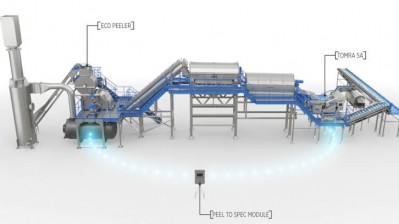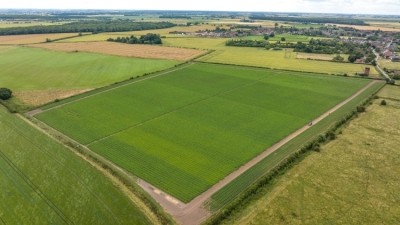Opinion
Finding efficiency through supply chain integration

One of the biggest topics in food processing today is supply chain integration. This brings together multiple stakeholders in the food production process to achieve greater efficiency, both in productivity and cost savings. But how do companies leverage the full breadth of what is possible?
In the last six months, I have been fortunate to see answers to this question when visiting vegetable and potato processing companies in Asia, Latin America, and the EMEA region. (I will also visit North American businesses in the coming months.) The most interesting and common topic we discussed at these businesses was raw material quality variation – and how organisations can utilise technology to extract the maximum good product from every piece of produce entering their processing facility.
Ag-tech has become a necessity
The world is suffering from extreme weather events, which don't only have devastating effects on communities, homes and families, but also disrupt farmers and growers, who now have to struggle more often to save their crops and meet the needs of food processors.
One consequence of this – and of progress – is that technology plays a more important role in monitoring weather and growing conditions. Drone use in agriculture is increasing – no longer the tool only of a privileged few, it is now a necessity for collecting data and enabling efficient crop spraying.
Customer needs are constantly changing in this industry. At TOMRA Food, we continuously challenge ourselves to focus on these, to develop the products and automation tools that help food processors achieve the highest performance. TOMRA integrates field sorting, steam peeling, and processor sorting solutions for growers and food processors in every region. These integrated technologies bring supply chain integration and enable processors to collect data from their input materials, aligning growers with processors' needs. This data also ensures that global food companies supply food of the same taste and quality, no matter which region it is sold in.
Some processors are integrated all the way from the field to the customer shelf. They supply the seeds to the fields and then select the correct seeds and variety based on the soil quality, the environment, and the required product specification (size, shape and quality). They work with laboratories to develop new cultivars with resilience to disease. And they ensure the soil has the correct level of nutrients to achieve the highest uniformity. By taking these measures, processors gain a valuable advantage because their process receives raw materials of higher quality and greater consistency.
For steam peeling, this is nirvana. High-quality raw material, consistent in shape and skin thickness and free from defects, means that steam times will be merely two to three seconds.
Unfortunately, however, this is not possible for all food processors because most are not integrated with growers, and they need to issue contracts to as many as 200 farmers for the supply of potatoes and other root vegetables. This provides a huge challenge because raw material's quality, size and shape vary continuously.
Solutions have got smarter
There is good news for the many food processors facing these challenges: solutions are now available to gather data from the field harvest and share this in a usable format to make ‘up-to-the-minute’ decisions in food processing facilities.
This is achieved by scanning and inspecting every piece of produce on the processing line to gather important data, then collecting and analysing this data in a cloud-based reporting system to ‘score’ the produce. Moreover, collecting data year-on-year from the same regions and fields can provide a transparent quality curve and specification for each field. This benefits both the grower, who can now charge a higher price for high quality, and the processor, who receives quantified assurances about the product quality paid for and received.
The integrated data-sharing between food processors and growers doesn’t only have a positive impact on the process line management of raw materials, it also improves steam peeling process efficiency. In turn, this improves the quality of peeled potatoes used to make IQF vegetables or frozen French fries, which reduces factory waste and enhances profits and results in the food processor being able to compete with neighboring food factories for valuable supermarket and QSR contracts—a truly integrated chain.
Huge value in data
Now that we fully understand the need and the benefit, how do we bring this integrated approach to every potato grower and processor?
What’s needed is a solution that can compile all the data collected over the past 5-10 years, then extract the relevant data and present it in an easy-to-use format. The most important part of this process is understanding which data is relevant.
When a processor receives 10 to 20 data parameters, not all correspond to a change in crop yield or vegetable characteristics. But by using the thousands of sorters TOMRA has installed worldwide, it’s possible to focus and refine data, then present important data with metrics in an easy-to-read chart or graph on the machine owners’ smartphone, tablet or desktop computer.
Important data is also integrated into the processing facility's SCADA (supervisory control and data acquisition) package. This enables processing to be tailored to maximise utilisation of the raw material. And when this data is input along with a customer specification, it is possible to create automated ‘Peel to spec’ and ‘Sort to spec’ processes for the potatoes or vegetables.
One example is the TOMRA Eco steam peeling and sorting module, an automatic quality and specification control solution. With up-to-the-minute adjustment, this ensures high yield and reduced energy consumption.
Another good example is the Sort-to-Spec intelligence system on the TOMRA 5B sorting machine. This continuously adapts the sort settings in real time to obtain maximum product quality at all times.
This kind of data application, leveraging the full breadth of an integrated supply chain, is already a reality at food processing companies. It’s made possible by TOMRA Food’s cloud-based customer portal and data platform, TOMRA Insight. This provides a secure, near real-time monitoring platform for peeling and sorting lines by automatically extracting data from sorting machines. Data about materials passing through the machines can be seen and responded to on the machine user’s touchscreen, enabling instant improvements in line efficiencies and product consistency. And digital metrics on the status and performance of sorters can be securely accessed from wherever, and whenever, processors wish.
So there is no secret sauce or magic to supply chain integration, but there is data – and there are now the tools to use it.
It is crucial for consistency, however, that all data collection tools are developed using a standard approach and a common platform and that they are developed with a knowledge of global growing and processing variations for vegetables and potatoes.
Make no mistake; supply chain integration is probably the most significant development we see in food today. Access to information by growers and processors helps them improve efficiency, quality and profits. And when they can securely share information with their partners and customers, they can create a transparent and trusted relationship where everyone prospers.


















